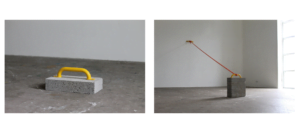
Manhandle, 2020 and Stack, 2020
Connor Shields is a Leeds based artist originally from Middlesbrough. Combining materials commonly associated with the construction industry, with those of knitting and textiles, he explores the concept of working-class masculinity through sculpture, and has more recently incorporated writing into his practice as another means to examine these topics. Since graduating from Leeds Arts University in 2018 he has produced an impressive body of work, won two residencies, was shortlisted for three prizes, awarded commissions and has consistently been making and exhibiting.
Court Spencer caught up with him in his city centre studio.
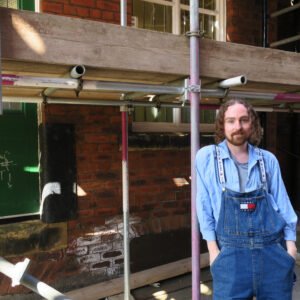
Connor Shields outside the studio
Court: Wow, this is my very first studio visit, in real life for the column! It’s so nice to be here, thanks for having me! What is this place and how long have you been here?
Connor: Thanks for coming Court. I’m really excited to have you here! My studio is at Aire Street Workshops, just by Leeds train station. I moved into this space just before Christmas, but I’m feeling quite settled here now. It’s a great location!
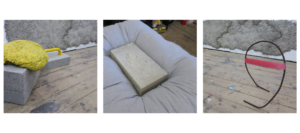
Works in progress
Court: It’s exciting to see some of your work in progress. I remember the first time I saw your work at your degree show and I was instantly drawn to it and was delighted that you were there and happy to chat. For most of your degree you were painting but towards the end, changed to sculpture. What was the appeal of sculpture and your choice of materials?
Connor: Thank you! Yes, I painted most of my way through university, but as my ideas evolved I felt they weren’t translating through the process of painting. I needed a totally different language for the ideas that I wanted to express and by chance I ended up taking part in a ceramics workshop. That was my introduction into thinking in a three-dimensional sense and I found this visual and material language that felt so new to me. The work said what I wanted it to say almost instantly, in a way that I wasn’t able to convey with painting.
As for the choice of materials, I began to think intuitively about what objects came to mind when I thought about these ideas and how they can be combined.
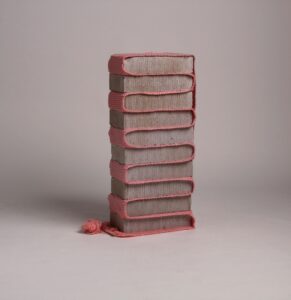
Disparity, 2018
Court: The materials you use can be read as representing qualities often associated with stereotypes of the masculine and the feminine. At times there is a tension between the contrasting qualities of the materials, yet in some instances they really complement or balance one another. Is this a reflection of your own experience? You come across as someone who is comfortable to embrace both aspects of your personality but is there a tension there and is this what you’re addressing/expressing in your work?
Connor: I think that is something that I found when I started making the sculptures. The materials were so disparate, yet there was a harmony when they were placed together. Almost a feeling like they were meant to be placed together. That sounds incredibly cliche, but I can’t describe it any other way. It was exciting to me. Definitely a turning point in my practice, and the first time I was making work that I was fully proud of.
As for my own experience, I definitely think that there is a reflection of these feelings and experiences relating to my upbringing in the work, albeit subconscious. The feelings I had growing up in a working-class town as a feminine boy. I think that gay and queer people from similar backgrounds can relate to the difficulties this can present. There were definitely times when I was perhaps afraid to engage in activities such as knitting because of how it presents you, particularly as a young boy. And that played a part in the knitting that features in my work today.
Court: Do you think society in general has quite rigid ideas of gender that could be seen as limiting and not necessarily allow people to present their whole self?
Connor: I believe so. Less so today than previously, but it’s still definitely quite rigid. I suppose your background and where you are brought up also is part of it. I definitely felt pressure to behave a certain way when I was growing up. I can’t speak for all experiences though, only my own.
I don’t speak so much about these ideas of gender in the same way quite as much. These ideas were my entry point into the work I make today. I worked through the ideas in their general and broad sense when I first started making this particular body of work. The focus right now is, and perhaps always has been, relating to masculinities from a working-class background.
Court: I think you’ve mentioned that some of your peers at school went into trades such as bricklaying or plumbing as that may have been what was expected of them. What did your parents do in terms of work? Did you always want to be an artist? And how did they react to your decision?
Connor: My dad left school and didn’t want to go to college so instead got a job in engineering through his dad, mainly in the chemical plants and steel works. He didn’t like the job so ended up going to college later, but there was, or is, this culture of getting a job in an industry through a parent. My mam also left school and didn’t want to go to college and began working for Barclays. She’s told me that when she was younger, most people would just go straight into work when they were leaving school. She now works as a fundraiser for a philanthropic charity.
I’m not too sure when exactly I decided I wanted to be an artist, but it was possibly not until my mid-teens. Although I always enjoyed art and making, it never felt like a career path when I was younger. My parents have always been supportive of me in whatever I decided to do.
Court: I know we all view the world through our own lens based on our upbringing, values and experiences etc. How do you think being a gay man impacts the work you make and what you want to say through your work?
Connor: I don’t consciously try to make work that has a gay or queer narrative, but like you said we each experience the world through our own unique lens, and these experiences definitely transfer onto the work, often subconsciously, for me at least. The ideas behind the work are not necessarily just of the ‘gay experience’ but that is one reading into it and undeniably part of my visual ‘lens’. At this point I don’t think too deeply about these ideas that underpin the work, but there is definitely an intuitive guide that draws my attention to the specific inspirations that influence the making.
Court: You were talking about some research you had been doing into Polari – a language used in Britain that was based on an amalgamation of words and slang from different backgrounds that allowed gay men and lesbian women to talk to one another without being understood by others. This was used when homosexuality was illegal and the use of it subsequently declined in the late 1960s. Can you talk to me a little about this and how it might inform or appear within your work?
Connor: Polari doesn’t currently feature in any of my previous works, but I have been doing research on the subject and imagine it will start to appear in future works, maybe in the titles. Writing is starting to become a part of my practice, so perhaps it could emerge within that. Maybe it will even go unnoticed by the majority of viewers; I guess that was the original purpose of Polari, so that would feel very fitting.
Court: Yeah, I suppose that would be really fitting if it were to just blend in and only those who knew about Polari would recognise it.
You’ve been commissioned to make new work for an upcoming group exhibition at Sunny Bank Mills. Can you tell us a little about that, what else you’re working on and how do these opportunities usually come about?
Connor: Yes, I am really excited to start working on my commission for Sunny Bank. They approached me on this occasion, which was great that my work was thought of in relation to the show theme. My process is usually quite intuitive and experimental, but this project has been a lot more research based. It feels like there has been a slight turning point and focus within my practice, so research is important within this stage of making. Once the research has settled within my brain the intuitive making then tends to follow. I’m also trying to pin down some dates for a couple of shows that were due to go ahead last year but couldn’t because of the pandemic. I hope they’re able to see the light of day later this year or even early next year.
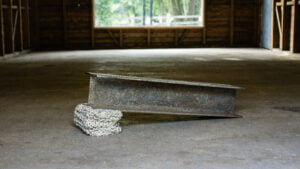
Resilience, 2018 at Yorkshire Sculpture Park. Image credit: @oliverallenphoto
Court: I know you’re only just really starting out in your career but what’s been some of the highlights thus far?
Connor: Being able to have a show at Yorkshire Sculpture Park in 2019 was definitely one of my career highlights! The staff there are great and have been very supportive of me since graduating from university. I was also really happy to be included in ‘Major Conversations: The Industrial Narrative’ at Platform A Gallery, in Middlesbrough. It felt like a very full circle moment to take the works back to where the inspiration initially came from.
It is always nice to be able to revisit with people that I worked with at earlier stages in my career. Like yourself Court, being one of the first people to approach me from the degree show to exhibit. And I recently did this virtual workshop/discussion with Steve Allen as part of the Zwischen series, a reimagining of the Bauhaus workbook. We talked about ideas of ‘Living In Plain Sight’ focusing particularly on ‘The Glass House’ by Philip Johnson. And Steve had been one of the first to review my work.
Court: And what are your hopes for your career? Have you got a dream project or something you would love to make happen, a space you would like to exhibit etc?
Connor: I am generally pretty open for my practice to take me wherever it goes. I’m happiest when I am making work. There is no better feeling than when a piece comes together, or a new idea emerges. That is the most exciting part for me.
That being said, I would like to make work for the public realm someday. I’ve definitely started to consider this and also think about the different factors that need to be considered when presenting work outside of a traditional gallery space. I would also like to start getting to know other art scenes close by like Sheffield and Manchester and hopefully get to show work in those cities too one day.
Court: As we slowly come out of lockdown in the UK, is there anything you’re particularly looking forward to doing?
Connor: I’m looking forward to seeing art in person again! That is going to be so exciting. Also, being able to show my own work again post-lockdowns!
Court: Well Connor I very much look forward to seeing more of your work again, thank you so much for letting me snoop through your studio! I’m really looking forward to seeing Material Matters at Sunny Bank Mills (12 June – 1 August). I’m a huge fan of your work and look forward to seeing what comes next.
Filed under: Art & Photography
Tagged with: art, Connor shields, court Spencer, design, discussion, gender, interview, knitting, LGBTQ, materials, photography, polari, queer art, sculpture, Studio, studio visit, Sunny Bank MIlls, Yorkshire Sculpture Park
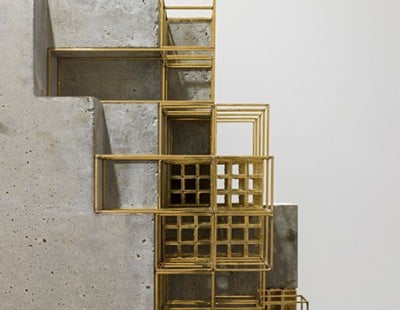
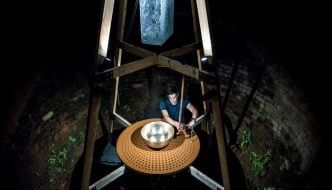
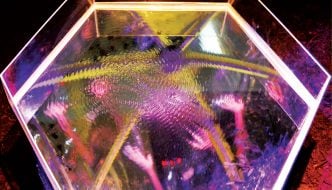
Comments